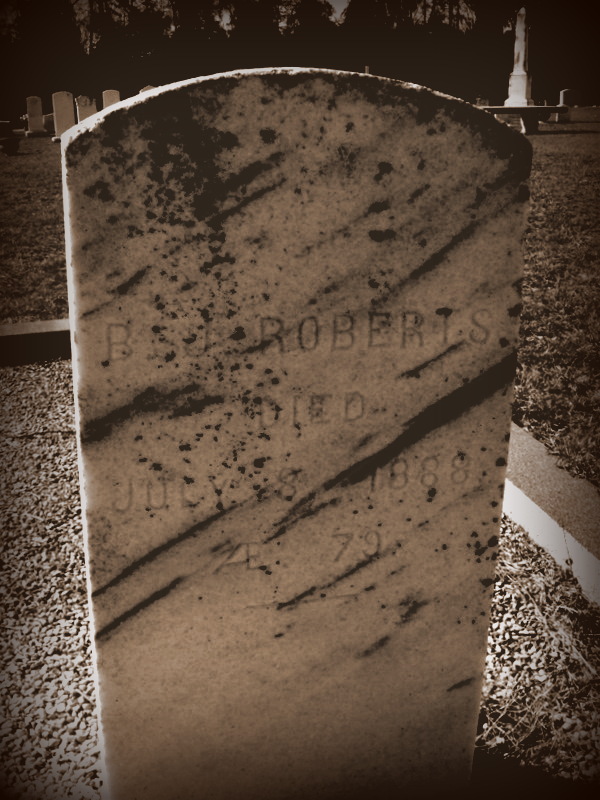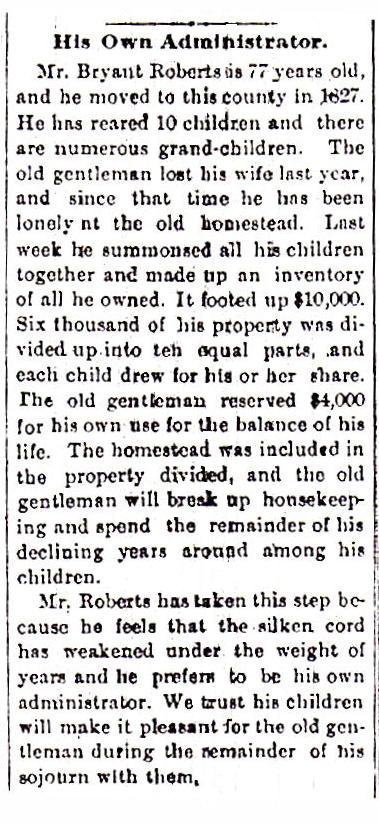Here is the story the way it was told by B. J. Roberts 50 years after the event:
The Valdosta Times
May 14, 1887
INDIAN FIGHTERS
A Brief Account of the Fighting In This Section In 1836.
Mr. Bryan J. Roberts, father of Mr. W. K. Roberts of this place, is one of the pioneers of Lowndes, and has seen service as an Indian fighter in this and Clinch counties. He is now in his 78th year and is spending the evening of his life very happily among his devoted children, having a few years ago divided a fine property among them, reserving for himself a sufficiency for his simple needs. His children are all prospering and he is happy in seeing them happy.
In 1836 the rumors of depredations and murders by Indians in other portions of the State caused widespread alarm in this section, and the citizens organized companies for the protection of their families and property. Capt. Levi J. Knight commanded the company to which Mr. Roberts belonged.
This company was on duty one hundred and five days, and during that time engaged in two bloody fights with the red skins.
In August, 1835, a squad of Indians raided Mr. William Parker’s home, not far from Milltown. They carried his feather beds out into the yard; cut them open, emptied the feathers, cut and carried the ticks with them. They also robbed him of provisions, clothing, and $208.25 in money.
Capt. Knight’s company was soon on the trail of this squad and in a short time overtook them near the Alapaha river, not far from the Gaskins mill pond. The sun was just rising when the gallant company opened fire on the savages. A lively fight ensued, but it soon terminated in the complete routing of the Indians, who threw their guns and plunder into the river and jumped in after them. A few were killed and a number wounded. One Indian was armed with a fine shot gun. This he threw into the river and tried to throw a shot bag, but it was caught by the limb of a tree and was suspended over the water. This bag contained Mr. Parker’s money, every cent of which he recovered as well as all the other property taken from his house. The fine gun was fished out of the river and, afterwards sold for $40, a tremendous price for a gun in those days. In the fight Mr. Peters was shot with this same gun. One buck-shot struck him just above the waist-band of his pants, passed through and lodged under the skin near the backbone. He was also struck by two shot in the left side, which made only slight wounds. The Indian was not more than thirty yards distant when he shot him. Mr. Peters recovered from his wounds in less than twelve months.
Having driven the Indians into the dense swamp beyond the river, Capt. Knight marched his company as rapidly as possible in the direction of Brushy creek, in the Southwestern portion of the county. When they arrived near that place, they heard a volley of small arms, and on arrival found that the battle had been fought and that the volley they heard was the last tribute of respect over the grave of their brave comrade-in-arms, Pennywell Folsom. Edwin Shanks and a man named Ferrell were also shot dead in the fight. Edwin Henderson was mortally wounded and died near the battlefield. Mr. Robert Parrish, Sr., who lives near Adel, had his arm broken by a bullet in this fight. The Indians lost 27 killed and a number wounded. We have no account of any prisoners being taken. The battle of Brushy Creek was fought in a low, marshy swamp where Indian cunning was pitted against the invincible courage of the Anglo-Saxon, and in five minutes after the fight opened there was not a live red skin to be seen.
From this place Capt. Knight marched his company to what is now Clinch county. He overtook the Indians at Cow Creek, where a sharp engagement took place, resulting in the killing of three and the taking of five prisoners. Mr. Brazelius Staten was dangerously wounded in this fight but finally recovered.
This ended the Indian fighting in which Capt. Knight’s company were engaged. Half a century has passed since then. Nearly all the actors in that brief but bloody drama are at rest beyond the stars. A few of them are still among us, the valiant pioneers of this country, who bared their breasts to the bullets of the savages in order that their descendants might possess this fair land in peace.
The following is a list, as near as can now be ascertained, of the living and dead of Capt. Knight’s company. The company numbered 120 men, many of whom came from neighboring counties, whose names cannot now be recalled.
LIVING–Bryan J. Roberts, Moses Giddens, John Studstill, Jonathan Studstill, Aaron Knight, Guilford Register, Echols county.) David Clements, William Giddens, John and Nathan Roberts, Fla.) (Zeke Parrish, Lowndes county,) John McMillain, John McDermid and Robert Parrish.
DEAD–George Henedge, Jeremiah Shaw, Daniel Sloan, John Lee, Moses Lee, James Patten, William J. Roberts, Isben Giddens, Jacob Giddens, Elbert Peterson, John Knight, Thomas Giddens, Harmon Gaskins, John Gaskins, William Gaskins, Sam Lee, Frederick Giddens, James Parrish, Martin Shaw, Archie McCranie, Daniel McCranie, Malcom McCranie, Alexander Patterson, James Edmondson, David Mathis, Thomas Mathis, Levi Shaw, William Peters, Jonathan Knight, Levi J. Knight and Brazelias Staten.
The Indians who passed through here belonged to the Creek Nation and were on their way from Roanoke to Florida to join the Seminoles. They were first discovered in this county by Samuel Mattox, at Poplar Head, near where Mr. Tom Futch now lives. Mattox was afterward hanged for murdering the fifteen-year-old son of Mr. Moses Slaughter. Most of these Indians reached the Okeefenokee Swamp where they were joined by a large band of Seminoles. From then until 1839 these savages did much damage to the white settlers in the vicinity of the Swamp, but in that year they were driven out and took refuge in the Everglades, where they were, with the exception of a small number, finally captured and sent to Arkansas.
Since the above was put in type another of the gallant old Indian fighters, Mr. Aaron Knight, has joined his comrades beyond the stars.
A 1915 reprint of this article also noted “The Malcolm McCranie referred to was the father of Mr. Geo. F. McCranie, cashier of the Bank of Willacoochee and Chairman of the Board of County Commissioners of Coffee.”

 THE CONFEDERATE LETTERS OF JOHN W. HAGAN. Part I
THE CONFEDERATE LETTERS OF JOHN W. HAGAN. Part I



